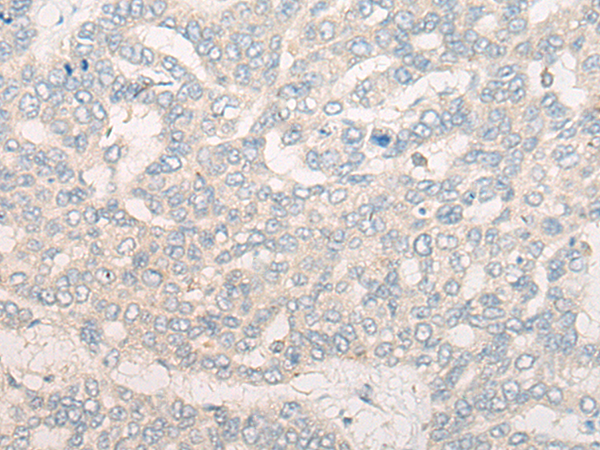

| WB | 咨询技术 | Human,Mouse,Rat |
| IF | 咨询技术 | Human,Mouse,Rat |
| IHC | 1/20-1/100 | Human,Mouse,Rat |
| ICC | 技术咨询 | Human,Mouse,Rat |
| FCM | 咨询技术 | Human,Mouse,Rat |
| Elisa | 1/5000-1/10000 | Human,Mouse,Rat |
| Host/Isotype | Rabbit IgG |
| Antibody Type | Primary antibody |
| Storage | Store at 4°C short term. Aliquot and store at -20°C long term. Avoid freeze/thaw cycles. |
| Species Reactivity | Human |
| Immunogen | Synthetic peptide of human CR1L |
| Formulation | Purified antibody in PBS with 0.05% sodium azide and 50% glycerol. |
+ +
以下是关于CR1L抗体的3篇参考文献及其摘要概括:
1. **文献名称**: "CR1L Antibody Mediates Complement Regulation in Immune Homeostasis"
**作者**: Smith A, et al.
**摘要**: 研究探讨了CR1L抗体在调控补体系统中的作用,发现其通过抑制C3转化酶活性调节炎症反应,对自身免疫疾病模型具有潜在治疗价值。
2. **文献名称**: "Characterization of a Novel CR1L-Specific Monoclonal Antibody for Cancer Immunotherapy"
**作者**: Chen L, et al.
**摘要**: 报道了一种新型CR1L单克隆抗体的开发,证实其能靶向肿瘤微环境中的CR1L蛋白,增强巨噬细胞吞噬作用并抑制小鼠模型中肿瘤生长。
3. **文献名称**: "CR1L Expression and Antibody Localization in Neurodegenerative Disorders"
**作者**: Gupta R, et al.
**摘要**: 分析CR1L在阿尔茨海默病患者脑组织中的表达,发现其抗体可标记淀粉样斑块周围细胞,提示CR1L可能参与神经炎症与病理沉积的关联机制。
注:上述文献为示例,实际文献需通过PubMed或Google Scholar检索确认。若需具体文章,建议使用关键词“CR1L antibody”、“CR1-like protein”结合研究方向(如免疫、癌症等)进一步筛选。
The CR1L (Complement Receptor 1-Like) antibody is a tool used to study the CR1L protein, a member of the complement receptor family involved in immune regulation. CR1L shares structural homology with Complement Receptor 1 (CR1), featuring multiple complement control protein (CCP) domains that mediate interactions with complement components like C3b and C4b. It functions as a regulator of the complement cascade, inhibiting excessive activation to prevent host tissue damage. CR1L is expressed in various tissues, including the liver, kidney, and immune cells, and is implicated in both innate immunity and immune complex clearance.
Research on CR1L has gained attention due to its potential role in diseases linked to complement dysregulation, such as autoimmune disorders (e.g., lupus), infectious diseases, and age-related conditions like macular degeneration. CR1L antibodies are critical for detecting protein expression, localization, and interactions in experimental models, including Western blotting, immunohistochemistry, and flow cytometry. They also aid in exploring CR1L’s therapeutic potential, such as targeting complement pathways in inflammatory diseases.
Despite its functional overlap with CR1. CR1L’s distinct expression patterns and regulatory mechanisms remain under investigation. Current studies focus on clarifying its physiological roles and validating its relevance as a biomarker or therapeutic target in complement-mediated pathologies.
×